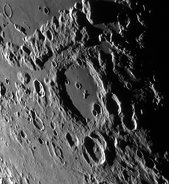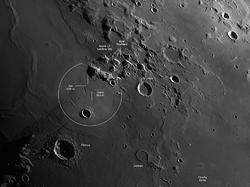 |
Chamäleon Observatory back moon
atlas about the image resolution HOME CHAMÄLEON |
|
In the following we show some picture examples with marginal image resolution. As described on the start page, the pratic image resolution in the deep red spectral range (680 nanometers) should be at about 700 meters in prime focus of the C14 and a video module with 3.75 x 3.75 microns pixel size in the middle of the moon. It should be noted that the image resolution is also significantly dependent on the image contrast and you have to distinguish between the terms "resolution" and "detectability". In principle, objects below the resolution limit can also be detected if the contrast to the environment is high enough see an example here.
All of the following image examples are located outside the center of the moon, sometimes in extreme peripheral locations, so that the small lunar structures appear much smaller due to the perspective directory. For all the examples shown here, the lunar distance was approximately 368,000 kilometers.
Click on the respective pictures to load large image file. The interesting details are labeled in the big pictures, respectively marked.
 |
 |
« « The first example shows the crater
Cleomedes
located just north of the Mare Crisium. The crater is close to the edge and in
the crater floor has a narrow channel system, the Rimae Cleomedes. Along the
main groove lie some - so-called - Dark Halo Craters (DHC) with pyroclastic
dark ash deposits - similar to the much larger DH crater in the complex crater
Alphonsus. Grooves and Dark Halo Craters are in the range of 1 to 2 kilometers and are clearly visible in our picture. « The picture shows a 130% scale of Cleomedes at sunrise, with this illumination, the groove system is clearly visible. Both pictures were taken in April 2017 and under |
 |
 |
« « second example shows a part of
Mare Nectaris. North of the large crater Fracastorius lies
Rosse. Below Rosse is a small cluster of secondary craters whose largest has a
diameter of 1,300 meters. Smaller craters are clearly visible. The in the
picture marked Dark Halo crater Beaumont L has exactly 4 kilometers in
diameter. The bright beam is ejection material of the Tycho Impact. « The LRO shows the cluster with an image resolution of 125m/pxl. |
 |
 |
« « On a picture of the region around
Maraldi/Gardner we noticed a nameless small lunar dome with
a small black dot on top of it. « The picture shows a 2x magnification and a glance at the high-resolution LRO moon map clearly showed a small summit caldera. The measuring tool of the LRO map was used to measure the dome and the summit opening in east-west direction. It results in a diameter of the dome of 3,700 - and the caldera of only 400 meters. The height of the dome above the surrounding area of about 180 meters. |
 |
« The
LRO
image shows the dome and the summit caldera with an image resolution of
64m/pxl. Thus, the highest possible resolution in the theory of about 400 meters pretty much corresponds to the practice of our moon shots. The largest visible crater in Maraldi D has a diameter of 2,700 meters in east-west direction. |
| Two last examples. |
 |
 |
« « The picture shows the
complex
crater Alphonsus with its groove system and the small Dark Halo craters and
also the crater chain Catena Davy. The image resolution is less than 1,000
meters. « shows next to the landing area of Apollo 17 two small lunar cones - Isis and Osiris - with dimensions of 950 and 600 meters, whereby the contrast of both structures is rather low. |
| top of page Home moon atlas |